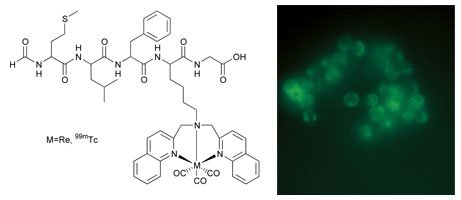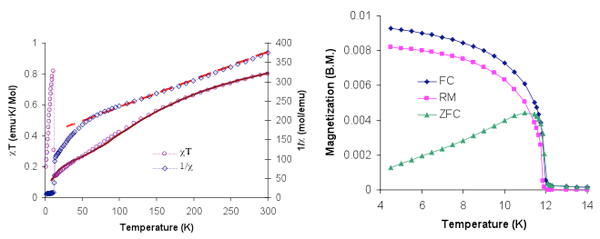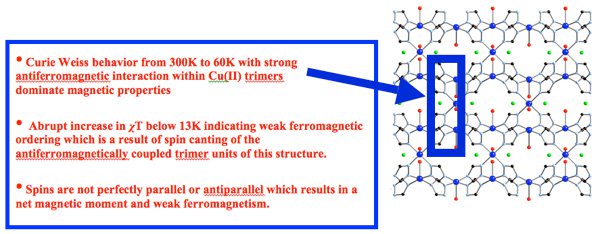
Jon Zubieta
- Chemistry
-
2-012 Center for Science and Technology
Email: jazubiet@syr.eduOffice: 315.443.2547
Research Specializations
Solid state coordination chemistry; radiopharmaceutical design
Research Interests
Technetium-99m has become the mainstay of diagnostic nuclear medicine and in some chemical form is used in the majority of the diagnostic scans performed each year in hospitals. One approach to the development of imaging agents involves tethering a 99mTc chelate moiety to a species known to possess high-affinity binding to a receptor, which may be accomplished by introducing a bifunctional chelate (BFC). The bifunctional ligand serves two purposes: to bind the metal radionuclide securely without dissociation in vivo and to provide a structural appendage for biomolecule linkage while maintaining maximal biomolecule integrity.
We have recently developed a BFC technology based on derivatized amino acids or synthetic amino acid analogues for the specific purpose of conjugation to small peptides by solid phase synthetic methods. Since the syntheses are carried out on an insoluble solid matrix which is freed from soluble by-products and excess reagents by washing with suitable solvents, time-consuming purification of the products at each stage may be avoided. Furthermore, protecting groups on the side-chains of the amino acids are retained until completion of the synthesis, whereupon the peptide-bifunctional chelate conjugate is detached from the insoluble support and purified by HPLC or ion-exchange chromatography. Thus, the synthetic approach offers considerable versatility in the design both of the peptide component and of the bifunctional chelating agent.

This versatility is demonstrated in the development of isostructural Re and 99mTc complexes for correlating fluorescence and radioimaging studies. Fluorescence microscopy allows accurate depiction of processes at the subcellular level and of complex systems such as protein trafficking within cells. The BFC technology we have developed provides complementary pairs of fluorescent and radioactive probes using Re and Tc, respectively. The figure illustrates the structure of a conjugate consisting of the {Re(CO)3}+1 core linked through a derivatized lysine to a peptide sequence, f-MLF[(SAACQ-Re(CO)3)+]G. The fluorescence microscopy image shows human leukocytes incubated with this reagent which has internalized into the cytoplasm of the cells. This methodology offers the unique opportunity to directly correlate in vitro and in vivo imaging studies, which goes a long way towards bridging the gap between work in isolated cells and studies carried out in living subjects.
We are also investigating the design of solid state materials with useful physical properties such as magnetism and sorption. Organic components are introduced to modify the inorganic substructure and to provide templates for the ultimate structure. The accompanying figures show a microporous material and a material with unusual magnetic properties.
Porosity of M(II)/1,2,4-Triazolate Open-Framework Structures: [Cu3(OH)3(trz)3(H2O)4]•4.5H2O

Magnetic Properties of M(II)/1,2,4-Triazolate: [Cu3(trz)4(H2O)3]F2


Degrees
- B.S., 1966, Fordham University
- Ph.D., 1971, Columbia University
- Postdoctoral Fellow, University of Sussex, England
Honors and Awards
- Woodrow Wilson Fellow, 1966
- National Institutes of Health Predoctoral Fellowship, 1967
- National Institutes of Health Postdoctoral Fellowship, 1971
- Chancellor’s Award for Excellence in Research, 1988
- Syracuse ACS Chapter Award, 2004
- Faculty of 1000, Biology
- Fellow of the Royal Society of Chemistry, 2009
Courses Taught
- CHE 109/119: General Chemistry, Honors & Majors
- CHE 411/611: Inorganic Chemistry
- CHE 625: Crystallography
Selected Publications
- Armatas, N.G.; Ouellette, W.; Whitenack, K.; Pelcher, J.; Liu, H.; Romaine, E.; O'Connor, C.J.; Zubieta, J. Construction of Metal-Organic Oxides from Molybdophosphonate Clusters and Copper-Bipyrimidine Building Blocks. Inorg. Chem. 2009, 48, 8897.
- Ouellette, W.; Zubieta, J. Solid state coordination chemistry of microporous metal-organic frameworks of the cadmium(ii)-4-pyridyltetrazolate family: the structural influences of chloride incorporation. Chem. Commun. 2009, 4533.
- Viola-Villegas, N.; Rabideau, A.E.; Bartholomä, M.; Zubieta, J.; Doyle, R.P. Targeting the Cubilin Receptor through the Vitamin B12 Uptake Pathway: Cytotoxicity and Mechanistic Insight through Fluorescent Re(I) Delivery. J. Med. Chem. 2009, 52, 5253.
- Ouellette, W.; Prosvirin, A.V.; Whitenack, K.; Dunbar, K.B.; Zubieta, J. A thermally and hydrolytically stable microporous framework exhibiting single-chain magnetism: structure and properties of [Co2(H0.67bdt)3] x 20H2O. Angew. Chem. Int. Ed. 2009, 48, 2140.
- Bartholomä, M.; Valliant, J.; Maresca, K.P.; Babich, J.; Zubieta, J. Single amino acid chelates (SAAC): a strategy for the design of technetium and rhenium radiopharmaceuticals. Chem. Comm. 2009, 493.
